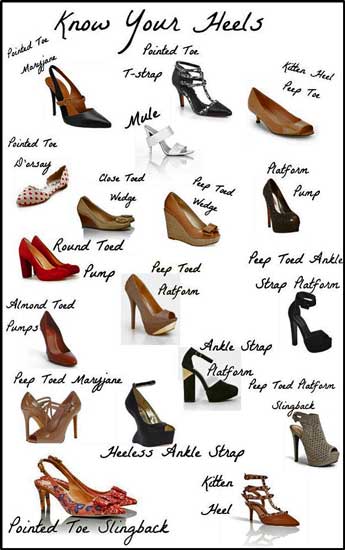 |
| So many high-heel shoe styles. (Photo from myshoe.world/en/) |
High Heels Hurt
Presumably because of space, the Time article summarized a 2014 survey from the American Podiatric Medical Association with one sentence. I thought it merited more.
The APMA’s online survey queried 1021 men and women, 18 and over, to gauge Americans’ attitudes toward foot health and podiatrists. The survey found 49% of women wear high heels and 71% of those who do experience pain, a much higher percentage than any other footwear. Barefoot running shoes and boots came next with just over 25% of women who wear them experiencing pain.
Despite the discomfort of high heels, the average woman who owns them has nine pairs. Most telling, even if shoes hurt, 38% of women still wear them if they like them.
Podiatrists recommend against wearing heels taller than 2 inches, yet almost half of the high-heel wearers can withstand heels that are 3 inches or more.
On the happy-feet side, almost half of the high-heel wearers rarely wear them, 5% wear them 5 days a week and only 2% wear them every day.
High Heels and Calf Muscle-Tendon Unit
Two of the three cited research studies addressed the effects of prolonged use of high heels on the calf muscle–tendon unit. A 2010 study from the UK’s Manchester Metropolitan University and Austria’s University of Vienna focused on the anatomical consequences; a 2012 study from Finland’s University of Jyväskylä and Australia’s Griffith University examined the neuromechanical consequences and walking.
Both studies performed detailed measurements and analyses--the 2010 study, of morphological parameters, muscle architecture, tendon mechanical properties and torque-angle relationships using magnetic resonance imaging, ultrasonography and a dynamometer; the 2012 study adding most notably 3-dimensional gait characteristics, ground reaction force and surface electromyography activity measured with cameras and reflective markers, a piezoelectric force walking platform and surface electrodes.
The only seeming shortfall with both studies was the small sample size: only 19 or 20 participants, split roughly between regular high-heel wearers and control.
The 2010 study found long-term use of high-heel shoes shortens the gastrocnemius muscle fascicles (connective tissue surrounding one of the two major calf muscles) and increases Achilles tendon size and stiffness, reducing the ankle's active range of motion.
The 2012 study found that, compared to walking barefoot, walking in high heels caused substantial increases in muscle fascicle strain and muscle activation. Long-term high heel use may compromise muscle efficiency in walking, lead to discomfort and muscle fatigue, and increase the risk of strain injuries.
High Heels and Knee Osteoarthritis
The other cited research study, led by Stanford University, was a recent assessment of the effects of heel height and weight on knees.
The researchers used marker-based gait analysis to capture knee parameters of 14 healthy females walking in different heel height footwear--flat, 3.8 cm (1.5 in) and 8.3 cm (3.27 in)--with and without a 20% bodyweight vest. Many of the changes observed were similar to those seen with aging and osteoarthritis progression, suggesting that high heel use, especially in combination with additional weight, may contribute to increased risk.
 |
| Wonder Woman wears high heels; 1949 comic book cover. (Photo from comics.gocollect.com/priceguide/view/113853) |
Though high-heel shoes aren’t something I would normally notice on a woman--well, maybe 9 inch heels--I have noticed female police detectives wearing high heels on TV shows. I finally confirmed how nonsensical that was with a retired police captain. On the other hand, I guess racing in high heels is a challenge some women can’t resist. I wish them luck.
Thanks for stopping by.
P.S.
High-heel shoes article on Time.com website:
time.com/3847330/you-asked-do-high-heels-actually-damage-my-feet/?xid=newsletter-brief
American Podiatric Medical Association survey:
www.apma.org/Media/PRdetail.cfm?ItemNumber=13076
www.apma.org/files/APMA2014TodaysPodiatristSurveyAllFindings.pdf
2010 paper in Journal of Experimental Biology:
jeb.biologists.org/content/213/15/2582.long
2012 paper in Journal of Applied Physiology:
jap.physiology.org/content/112/6/1054
2015 paper in Journal of Orthopaedic Research:
onlinelibrary.wiley.com/doi/10.1002/jor.22775/full
Videos on how to run and racing in high heels:
www.youtube.com/watch?v=h1LkVhBvEIk
www.youtube.com/watch?v=WJ2DC2X1e5k

No comments:
Post a Comment